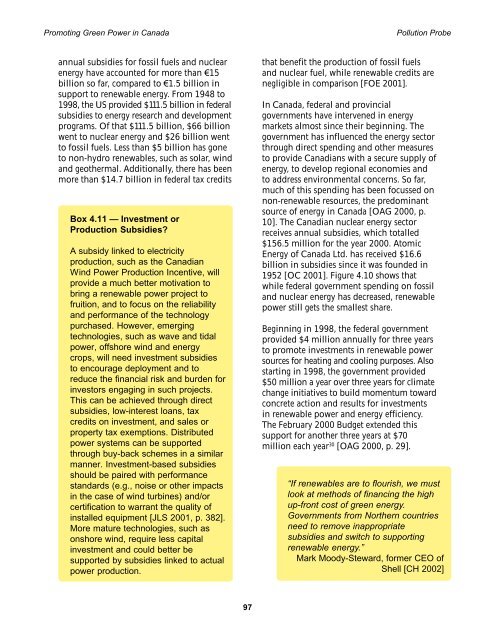Promoting Green Power in Canada - Centre for Human Settlements
Promoting Green Power in Canada - Centre for Human Settlements
Promoting Green Power in Canada - Centre for Human Settlements
- No tags were found...
Create successful ePaper yourself
Turn your PDF publications into a flip-book with our unique Google optimized e-Paper software.
<strong>Promot<strong>in</strong>g</strong> <strong>Green</strong> <strong>Power</strong> <strong>in</strong> <strong>Canada</strong> Pollution Probeannual subsidies <strong>for</strong> fossil fuels and nuclearenergy have accounted <strong>for</strong> more than €15billion so far, compared to €1.5 billion <strong>in</strong>support to renewable energy. From 1948 to1998, the US provided $111.5 billion <strong>in</strong> federalsubsidies to energy research and developmentprograms. Of that $111.5 billion, $66 billionwent to nuclear energy and $26 billion wentto fossil fuels. Less than $5 billion has goneto non-hydro renewables, such as solar, w<strong>in</strong>dand geothermal. Additionally, there has beenmore than $14.7 billion <strong>in</strong> federal tax creditsBox 4.11 — Investment orProduction Subsidies?A subsidy l<strong>in</strong>ked to electricityproduction, such as the CanadianW<strong>in</strong>d <strong>Power</strong> Production Incentive, willprovide a much better motivation tobr<strong>in</strong>g a renewable power project tofruition, and to focus on the reliabilityand per<strong>for</strong>mance of the technologypurchased. However, emerg<strong>in</strong>gtechnologies, such as wave and tidalpower, offshore w<strong>in</strong>d and energycrops, will need <strong>in</strong>vestment subsidiesto encourage deployment and toreduce the f<strong>in</strong>ancial risk and burden <strong>for</strong><strong>in</strong>vestors engag<strong>in</strong>g <strong>in</strong> such projects.This can be achieved through directsubsidies, low-<strong>in</strong>terest loans, taxcredits on <strong>in</strong>vestment, and sales orproperty tax exemptions. Distributedpower systems can be supportedthrough buy-back schemes <strong>in</strong> a similarmanner. Investment-based subsidiesshould be paired with per<strong>for</strong>mancestandards (e.g., noise or other impacts<strong>in</strong> the case of w<strong>in</strong>d turb<strong>in</strong>es) and/orcertification to warrant the quality of<strong>in</strong>stalled equipment [JLS 2001, p. 382].More mature technologies, such asonshore w<strong>in</strong>d, require less capital<strong>in</strong>vestment and could better besupported by subsidies l<strong>in</strong>ked to actualpower production.that benefit the production of fossil fuelsand nuclear fuel, while renewable credits arenegligible <strong>in</strong> comparison [FOE 2001].In <strong>Canada</strong>, federal and prov<strong>in</strong>cialgovernments have <strong>in</strong>tervened <strong>in</strong> energymarkets almost s<strong>in</strong>ce their beg<strong>in</strong>n<strong>in</strong>g. Thegovernment has <strong>in</strong>fluenced the energy sectorthrough direct spend<strong>in</strong>g and other measuresto provide Canadians with a secure supply ofenergy, to develop regional economies andto address environmental concerns. So far,much of this spend<strong>in</strong>g has been focussed onnon-renewable resources, the predom<strong>in</strong>antsource of energy <strong>in</strong> <strong>Canada</strong> [OAG 2000, p.10]. The Canadian nuclear energy sectorreceives annual subsidies, which totalled$156.5 million <strong>for</strong> the year 2000. AtomicEnergy of <strong>Canada</strong> Ltd. has received $16.6billion <strong>in</strong> subsidies s<strong>in</strong>ce it was founded <strong>in</strong>1952 [OC 2001]. Figure 4.10 shows thatwhile federal government spend<strong>in</strong>g on fossiland nuclear energy has decreased, renewablepower still gets the smallest share.Beg<strong>in</strong>n<strong>in</strong>g <strong>in</strong> 1998, the federal governmentprovided $4 million annually <strong>for</strong> three yearsto promote <strong>in</strong>vestments <strong>in</strong> renewable powersources <strong>for</strong> heat<strong>in</strong>g and cool<strong>in</strong>g purposes. Alsostart<strong>in</strong>g <strong>in</strong> 1998, the government provided$50 million a year over three years <strong>for</strong> climatechange <strong>in</strong>itiatives to build momentum towardconcrete action and results <strong>for</strong> <strong>in</strong>vestments<strong>in</strong> renewable power and energy efficiency.The February 2000 Budget extended thissupport <strong>for</strong> another three years at $70million each year 30 [OAG 2000, p. 29].“If renewables are to flourish, we mustlook at methods of f<strong>in</strong>anc<strong>in</strong>g the highup-front cost of green energy.Governments from Northern countriesneed to remove <strong>in</strong>appropriatesubsidies and switch to support<strong>in</strong>grenewable energy.”Mark Moody-Steward, <strong>for</strong>mer CEO ofShell [CH 2002]97
















